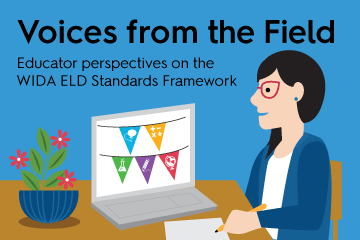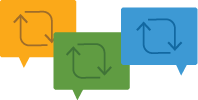WIDA Voices from the Field: Working with math by beginning with the end in mind

As an educator with more than 20 years of experience, I have heard this phrase more times than I can count. I have heard it in workshops, college classes and district trainings. According to Stephen Covey, beginning with the end in mind is the second of seven habits successful people practice. But why is it so hard for us to do?
Teachers are Lifelong Learners
As educators, we are lifelong learners. We are on a journey and happy to share our love for learning with all that enter our classrooms. Our math and science classes taught us how to be successful, how to persevere and work a problem through to the end where the answer would reveal itself. In math, sometimes it matched the answer in the back of the math book and sometimes it did not! In science, procedural experiments were given to us in the form of a lab. We might predict an outcome but as budding scientists we recreated labs that had typical outcomes to build our background knowledge and skills. We were learning. Oh how we all love the journey of learning!
The Journey and the Destination
There are so many words in education to describe the destination. Some of those terms include: objective, learning target, goal, outcome and endpoint. To begin with the end in mind, we must choose an endpoint and turn our backs on the innumerable alternative things students could learn each and every day. For this reason, maybe we choose not to commit to a clear, cohesive, measurable endpoint because we are conflicted between commitment to the goal and the many great possibilities of learning – and of course we must also maintain flexibility for what our students need in the moment. Another reason to not define a clear endpoint is that we ourselves may be hazy about what we are trying to achieve. Beginning with the end in mind is challenging. However, to support our students with clarity and certainty as they simultaneously develop content and language, this is essential for success. We can focus our minds by asking ourselves and our colleagues a tough question.
The Tough Question
What do you want the students to produce to demonstrate their understanding? This question has always been one of the toughest questions for colleagues to answer. Typically, answers begin with some sort of objective. Then, they walk through what they are going to teach and how they are going to teach it. This is a typical response and one I also leaned toward in professional conversations. However, the most successful lessons, from my experience, have always been when we can precisely articulate and create a model of what a student would produce at the end of a lesson or unit. Then we can work together through planning to achieve our measurable endpoint.
Begin with the End in Mind, 1st grade math
A colleague and I began with the end in mind when first grade students were having trouble describing number bonds. They could not articulate their thinking clearly to the teacher and the teacher was not sure if they were understanding what she was teaching. When I asked the tough question, she looked at me and described what she hoped to see. I asked her to be more specific. I asked her what she hoped to hear a student say when asked to describe the number bond. She said, “3 is a part, 4 is a part and 7 is the whole.” We wrote down a sentence frame and began to encourage the students to describe the whole number bond using the sentence frame. Soon, the entire class began to talk more like mathematicians by answering questions about number bonds using the sentence frame designed by the teacher. Along with other supports (e.g., explicit teaching and modeling language and content, offering ample time for discussing shared experiences, leveraging student’s home languages and multimodal communication), the teacher focused on helping students expand their answers from one word – such as 3, 4 or 7 – into more elaborated mathematical discourse. What I have learned as a teacher and a coach is that when we can articulate and create a model of what we expect students to produce at the end, the design of the lesson or unit is focused on reaching that endpoint.
Our Journey to the Endpoint and the WIDA ELD Standards Framework
By beginning with the end in mind, we had a clear understanding of our endpoint and the language we thought students would need to engage with grade-level content. But we were not done. The next step was for us to check how the WIDA English Language Development Standards Framework, 2020 Edition, could help us make language visible for our students. This was our process:
First, we looked at the Distribution of Key Language Uses table (p. 63). Inform is the predominant Key Language Use for math in grade 1. In our focus task, students were definitely being asked to inform the teacher of their understanding of number bonds.
Next, we looked for the Language Expectation associated with grade 1 math Inform. We found that the Language Expectation ELD-MA1.Inform.Expressive (page 70) helped us to further analyze what students were being asked to do with language in the task: “construct a mathematical informational text that describes a concept or entity.” Then, we examined the sample Language Features and found that indeed, “common phrasal verbs (e.g., part of, put together)” are important to help students get more precise as they describe this kind of mathematical concept.
From this information we were able to have a clear language goal for the unit. This language goal allowed us to identify clear endpoints for each lesson. It guided us and helped us continue to have a clear understanding of language students needed to interpret and express their learning in the Eureka math unit we worked on together. In the end, when the students were tested, this class was in the top three classes for their median growth score in a K-4 school with more than 25 classrooms.
About the series: Voices from the Field
Fernanda Marinho Kray, WIDA ELD Standards Framework project lead, and Margo Gottlieb, WIDA co-founder and consultant, have been hearing from a variety of educators about how they are making sense of the 2020 Edition. In response, the WIDA ELD Standards Framework team established this “Voices from the Field" series to present ideas, practices and tools for educators as they explore various avenues for standards framework implementation.
About the author
Patricia Aube is an instructional coach. She has been working for 22 years in a small urban school district to build a stronger school community to support the unique needs of multilingual learners with a focus on math and science education. Patricia is the principal author of Language Central for Math and Language Central for Science. She has worked as a general education teacher, dual-language teacher, coach, professional development provider and curriculum writer.
To stay informed about WIDA ELD Standards Framework resources, tools and services use the news sign up form to manage email preferences and select WIDA ELD Standards as an interest area.





